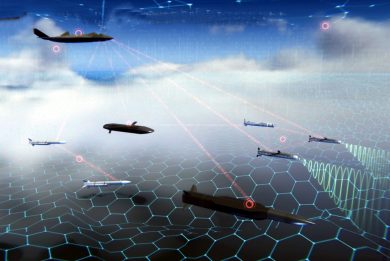
Aero India 2025 – First public appearance for Hindustan Aeronautics CATS Warrior autonomous UCAV
Four years after showing a scale model at Aero India, Hindustan Aeronautics Limited (HAL) exhibited for the first time in real its CATS Warrior, CATS being the acronym for Combat Air Teaming System. This is one of the CATS programme elements that are being developed by HAL
In January 2025 HAL announced the successful engine ground run of the full-scale CATS Warrior demonstrator, one more step towards the maiden flight of the Indian unmanned combat air vehicle (UCAV). According to information obtained at Aero India, taxi trials should start shortly after the closure of the Bengaluru exhibition, the first flight being tentatively scheduled for late 2025-early 2026.

The functional, full-scale engineering demonstrator seen at the show is powered by two HAL PTAE-7 turbojet engines, each engine delivering a thrust output of 3.7kN (380 kgf) with a specific fuel consumption of 1.15kg/kgf/hr; the air intake is on the top of the fuselage, a choice probably done to reduce the aircraft visibility. Each engine has a mass of 65 kg, is 1.27 metres long and has a diameter of 330 mm. It is 9.1 metres long and has a 7.6 metres wingspan; the configuration sees a mid-wing and a V-shaped tailplane.
Doubts remain about the maximum take-off mass, which should be around 2,000 kg, although some sources mention a lower mass. If the 650 kg payload is confirmed, then the 2000+ kg figure should be right. A rendering made available by HAL on its website shows the CATS Warrior armed with three SAAW (Smart Anti-Airfield Weapon), which mass is around 125-130 kg, two of them in the central weapon bay and one under the left wing pylon, the right wing carrying an AMRAAM air-to-air missile. All in all, the load should be close to the 600 kg figure.

The CATS can reach a maximum speed short of 800 km/h, no information being available if this can be obtained in the clean configuration, only with internal weapons, or in the full armed configuration. Maximum declared range is 800 km, here too mission payload and mission profile being critical.
An autonomous UCAV, the CATS Warrior is equipped with state-of-the-art avionics, including an active Electronically Scanned Array (AESA) radar and electro-optical/infrared sensors, enabling it to perform complex surveillance and target acquisition tasks. Operational autonomy is enhanced by an advanced artificial intelligence-based software system, which reduces the need for human intervention during missions and allows the drone to make critical decisions regarding route planning, threat detection, and combat strategies. Additionally, it features an inertial navigation unit and a jammer.
The CATS Warrior can be used in a variety of roles, such as strike missions, attacking high-value targets such as enemy airfields, reconnaissance, and surveillance. It can also be used for long-range combat missions, and should the need arise crash on the target with its combat payload to neutralize a critical enemy asset. Of course it can operate as part of a manned-unmanned team, acting as a loyal wingman to fighter aircraft, which in the case of India would be the Light Combat Aircraft (LCA) Tejas and the Advanced Medium Combat Aircraft (AMCA).
The CATS Warrior can be launched from a runway, thanks to its tricycle landing gear, from an aircraft carrier or from a mother aircraft, such as the LCA Tejas, Sukhoi 30MKI, and Jaguar.
The CATS Warrior is the first of a family of four CATS unmanned platforms currently under development.
Graphic courtesy HAL, photos by J. Roukoz



